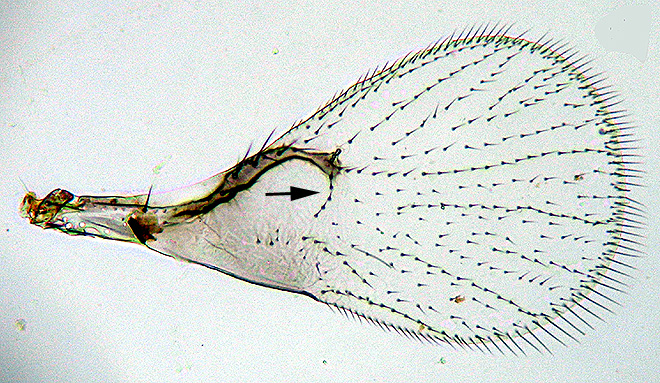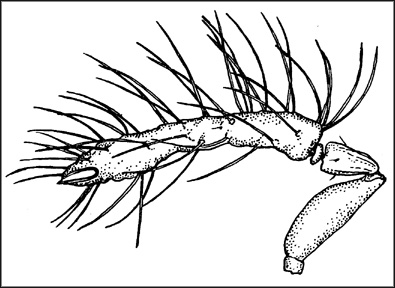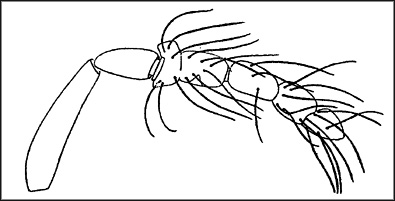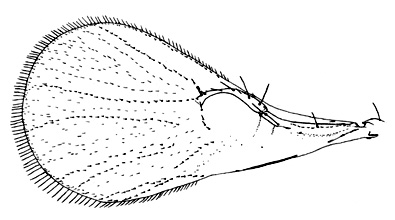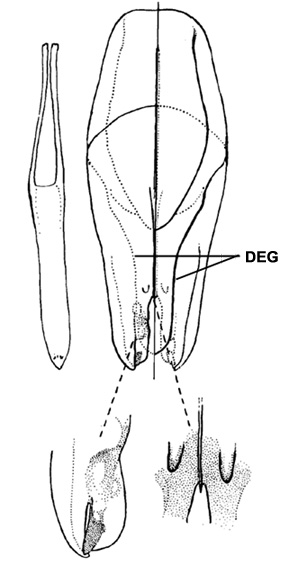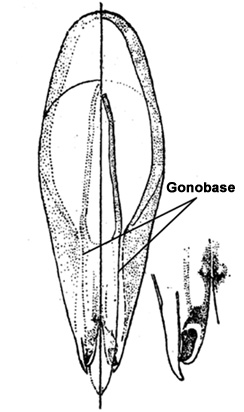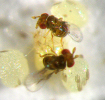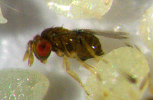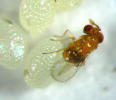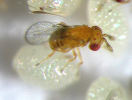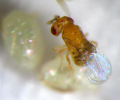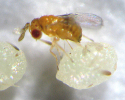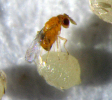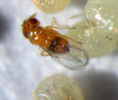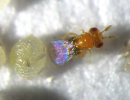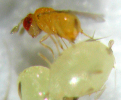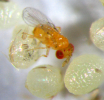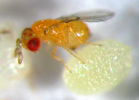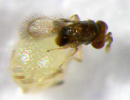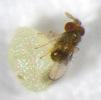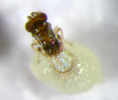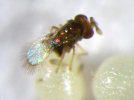 |
|
Egg parasitoids belonging to the family Trichogrammatidae are among the most widely used biological control agents in the field. Currently there are about 85 genera in the world (Viggiani,
2001), among which 26 have been recorded from India (Yousuf & Shafee, 1987). Of these, the genus Trichogramma Westwood, with about 250 species distributed across the world, is the most important one from the applied point of view. Trichogrammatoidea Girault, another important genus, has a much more
restricted distribution than Trichogramma with only 24 species known so far, mainly from the southern hemisphere and the Oriental region.
In India, many species of Trichogrammaand Trichogrammatoidea (predominantly the former) have been used in applied / augmentative biological control programmes. The distinguishing characters between the two genera are summarized below. Distinguishing features between Trichogramma and TrichogrammatoideaTrichogrammatids used in augmentative biological control in India |
 |
Scientific nameTrichogramma achaeae Nagaraja & Nagarkatti
DescriptionAdults 0.5 mm long and 0.15 mm wide across head. Males yellow with blackish sides of pronotum, mesonotum, mesopleurae, abdomen, hind coxae and femora. Antenna (Fig. 1) with long hairs, the longest being nearly 2.5x as wide as flagellum. Genitalia with prominent well-chitinized dorsal expansion of gonobase, which is subtriangular and apically blunt, nearly reaching tips of gonoforceps and sides of extruded portion being almost parallel (Fig. 4). Aedeagus (Fig. 3) about 1.5x as long as apodemes. Chelate structures (Fig. 5) in level with tips of gonoforceps. Minute protuberances present at base of chelate structures, one on either side of median ventral projection (Fig. 6), which is minute and inconspicuous.
Females similar to males when reared on same host and under same temperature conditions except for darker head. Antennae clubbed with few short hairs on flagellum. 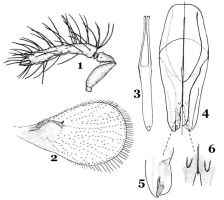 Figs. 1-6. Trichogramma achaeae: 1. Male antenna, 2. Forewing, 3-6. Male genitalia: 3. Aedeagus, 4. Genital capsule, 5. Chelate structure, 6. Median ventral projection ImagesDistributionIndia: Widely distributed. Russia. USA. West Indies.
HostsAchaea janata (L.).
|
 |
Scientific nameTrichogramma pretiosum Riley
Trichogramma brasiliense auctt. Trichogramma brasiliensis auctt. DescriptionMale: Yellow with blackish mesoscutum and abdomen. Antennal hairs finely tapering and moderately long, the longest being 2.5x maximum width of flagellum. Trichiae arranged somewhat
irregularly on forewing. Fringe on tornus of forewing about 1/6th width of wing. Male genitalia with DEG highly chitinised, triangular, basally constricted. CS far below level of tips of GF. MVP distinct, almost reaching level of CS. CR paired, extending anteriorly to about two-thirds length of genitalia. Aedeagus slightly longer than apodemes, both together distinctly shorter than hind tibia.
Female: Yellow with blackish anterior and posterior abdominal tergites. Antenna clubbed with few short hairs on flagellum. Ovipositor either slightly shorter than or equal to hind tibia. 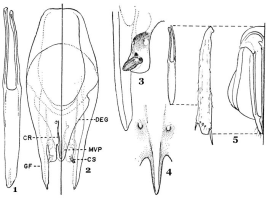 Figs. 1-5. Trichogramma pretiosum: 1-4. Male genitalia: 1. Aedeagus, 2. Genital capsule, 3. Chelate structure, 4. Median ventral projection, 5. Relative lengths of aedeagus, hind tibia and ovipositor HostsSugarcane borers.
ImagesRemarksThe species introduced into India as Trichogramma brasiliense by the erstwhile Commonwealth Institute of Biological Control, Indian Station, in the late 1960s and '70s has been found to be T. pretiosum based on morphological evidence and hybridization / crossing studies. The original T.brasiliense is presently combined with Trichogrammatoidea as the type species has been found to belong to Trichogrammatoidea. Hence, the available Indian publications on T. brasiliense actually refer to T. pretiosum.
|
 |
Scientific nameTrichogramma chilonis Ishii, 1941
SynonymsTrichogramma chelonis Ishii
Trichogramma (Trichogramma) chilonis Ishii, 1941 Trichogramma chilones Ishii Trichogramma confusum Viggiani, 1976 Description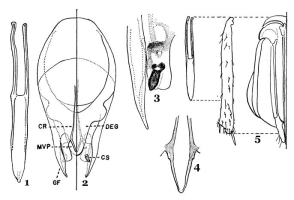 Figs. 1-5. Trichogramma chilonis: 1-4. Male genitalia: 1. Aedeagus, 2. Genital capsule, 3. Chelate structure, 4. Median ventral projection, 5. Relative lengths of aedeagus, hind tibia and ovipositor DistributionWidely distributed almost throughout India. Widely distributed in the Oriental region. Pakistan, Bangladesh, Nepal, China, Malaysia, Indonesia, Philippines, Japan, South Africa, West Indies,
Europe, USA, Hawaiian islands.
ImagesHostsSeveral hosts have been recorded worldwide, primarily in Lepidoptera and also Diptera, Coleoptera, and Neuroptera. Some of the major pests against which it has been used / recorded in India include sugarcane borers (Chilo infuscatellus, Chilo sacchariphagus indicus, C. auricilius, Emmalocera depressella, Raphimetopus ablutellus, Acigona steniellus, Scirpophaga excerptalis), rice stemborer (Scirpophaga incertulas), leaffolder (Cnaphalocrocis medinalis), coconut blackheaded caterpillar (Opisina arenosella), diamondback moth (Plutella xylostella), and cotton bollworms (Earias vittella, E. insulana, Helicoverpa armigera, Pectinophora gossypiella).
Field applicationThis is perhaps the most widely used biological control agent in the field in Indian conditions, particularly on sugarcane.
|
 |
Scientific nameTrichogramma chilotraeae Nagaraja & Nagarkatti
DescriptionAdults 0.51 mm long and 0.2 mm wide across head. Males yellow with blackish pronotum, mesopleurae, mesoscutum, abdominal terga and hind coxae. Antennal flagellum unsegmented with long hairs, the longest being more than 3x maximum width of flagellum. Genitalia with more or less triangular dorsal
expansion of gonobase, having a tapering apex which does not project beyond gonoforceps, but extends only to level of chelate structures. Aedeagus prominent and long, 1.2x as long as apodemes, projecting beyond gonoforceps (almost as long as or slightly longer than entire male genitalia). Large chelate structures
located far below level of tips of gonoforceps. Protuberances at base of chelate structures very minute and inconspicuous. Median ventral projection very distinct and long, with two chitinous ridges extending anteriorly only for a short distance from median ventral projection. Aedeagus together with apodemes
slightly shorter than hind tibia.
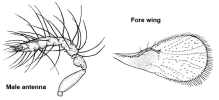  Figs. 1-2. Trichogramma chilotraeae: 1. Aedeagus, 2a&b. Male genitalia: 2. Genital capsule, 2a. Chelate structure, 2b. Median ventral projection Females resemble males in colour, with the following differences: one or more penultimate abdominal tergites appear yellow in the middle and the anterior portion of mesoscutum is black. Antennae typically clubbed with few short hairs. ImagesHostsChilo infuscatellus (Snellen).
DistributionIndia: West Bengal.
|
 |
Scientific nameTrichogramma embryophagum (Hartig)
SynonymsEncyrtus embryophagus Hartig, 1838
Ichneumon (Encyrtus) embryophagum (Hartig, 1838) Ooencyrtus embryophagus (Hartig, 1838) Trichogramma embryophagum (Hartig, 1838) HostsPectinophora gossypiella, Sitotroga cerealella, Agrotis segetum, Opisina arenosella, Pieris brassicae, Corcyra cephalonica, Cydia pomonella. Complete list of hosts / associates can be found in the Universal Chalcidoidea Database (Online at http://internt.nhm.ac.uk/jdsml/perth/chalcidoids/).
Images |
 |
Scientific nameTrichogramma japonicum Ashmead
DescriptionMale: Dull yellow with thorax and abdominal tergites black. Antennal hairs long, sharply tapering, the longest being about 3.5x maximum width of flagellum. Fringe on tornus of forewing nearly one-fifth width of wing. Fringe on outer margin and tornus nearly equal in length. Genitalia
with DEG highly sclerotized, horseshoe-shaped with blunt posterior extremity, sides of DEG extend slightly beyond sides of genitalia. CS far below the level of tips of GF. MVP inconspicuous, the entire region highly chitinised. CR paired, extending to about two-thirds length of genitalia. Aedeagus distinctly longer than apodemes, both together as long as or very slightly longer than hind tibia.
Female: Dull brownish yellow with black sclerites. Antenna clubbed with few short hairs on flagellum. Ovipositor nearly 1.5x as long as hind tibia. 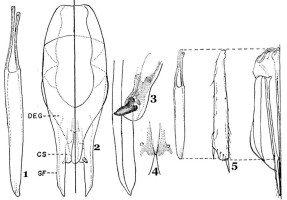 Figs. 1-5. Trichogramma japonicum: 1-4. Male genitalia: 1. Aedeagus, 2. Genital capsule, 3. Chelate structure, 4. Median ventral projection, 5. Relative lengths of aedeagus, hind tibia and ovipositor Images
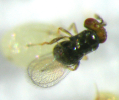
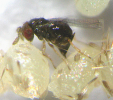
 Adults parasitising the eggs of C. cephalonica Adults parasitising the eggs of C. cephalonica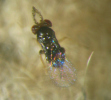
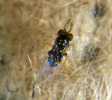 Adult on the egg mass of Scirpophaga incertulas (Walker) Adult on the egg mass of Scirpophaga incertulas (Walker)
HostsRecorded on several 250 hosts worldwide. Some of the major pests of the Indian region parasitised by this species are Chilo partellus, C. infuscatellus, C. sacchariphagus indicus, C. suppressalis, C. auricilius, Cnaphalocrocis medinalis, Scirpophaga incertulas, S. excerptalis, Raphimetopus
ablutellus, Leucinodes orbonalis, Helicoverpa armigera, and Plutella xylostella.
Field applicationRecommended as part of BIPM packages in rice and sugarcane for the control of stem and tissue borers.
|
 |
Scientific nameTrichogrammatoidea bactrae Nagaraja
SynonymsTrichogrammatoidea bactrae fumata Nagaraja, 1979
Trichogrammatoidea bactrae bactrae Nagaraja, 1979 Trichogramma bactrae Nagaraja, 1979 Description
Length 0.4-0.5 mm, width 0.15-0.18 mm. Head dull yellowish brown; eyes and ocelli red, antenna light brownish grey. Pro- and mesothorax, scutellum and metanotum dull yellowish brown to black Legs yellowish brown, mid- and hind femora greyish brown. Abdomen with tergites black, ventral side lighter. Antenna (Fig. 1) with flagellum about 1.75x as long as scape, with 22-26 long hairs, the longest being nearly 3x as wide as flagellum. Forewing (Fig. 2) as illustrated. Hind wing with
fringe setae as long as in fore wing. Male genitalia (Fig. 4) narrow, nearly 3x as long as wide; apex and base indistinctly tapering, median cleft slightly less than a fifth of the length of genitalia; median ventral projection not conspicuous, lateral tubercles distinct, chelate structures (Fig. 5) large, slightly below level of gonoforceps. Aedeagus and apodemes of nearly equal length, aedeagus with apodemes nearly three-fifths the length of hind tibia. Female similar to male in general
appearance, with ovipositor as long as hind tibia (Fig. 3).
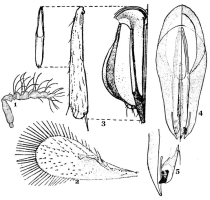 Figs. 1-4. Trichogrammatoidea bactrae: 1. Male antenna, 2. Forewing, 3. Relative lengths of aedeagus, hind tibia and ovipositor, 4. Genital capsule, 5. Chelate structure DistributionThroughout the Oriental region.
ImagesHostsLepidoptera: Bactra venosana Zeller, Pelopidas mathias (F.), Trichoplusia ni (Huebner), Agrius convolvuli (L.), Emmalocera depressella Swinh., Chilo infuscatellus Snellen, C. partellus (Swinhoe), Chilo sacchariphagus venosatus Walker, Helicoverpa armigera (Huebner) and several other hosts. Diptera: Sepedon
sauteri Hend. Mass production of TrichogrammaThe eggs of rice moth, Corcyra cephalonica (Stainton), are used for the mass production of trichogrammatids in most of the commercial insectaries in India, though the eggs of Angoumois grain moth, Sitotroga cerealella (Olivier), are also used to a limited extent. Jalali et al. (2003) have given the detailed production procedure for C. cephalonica, with details on methods of field release, dosage, etc. References
|
